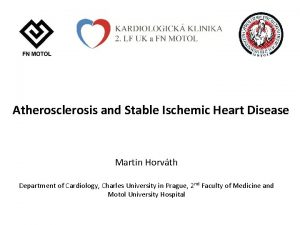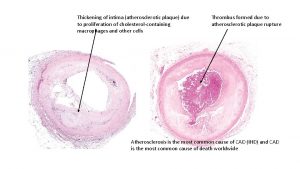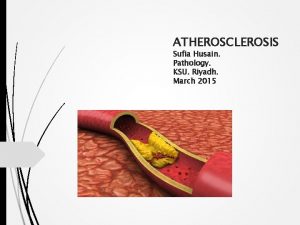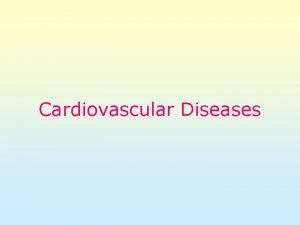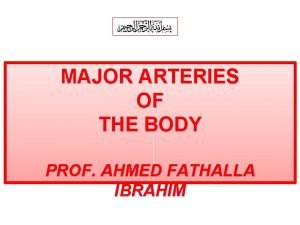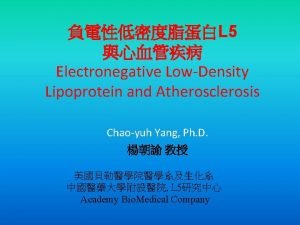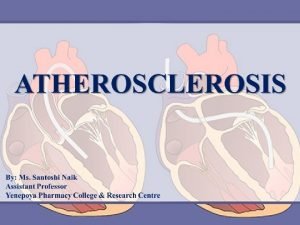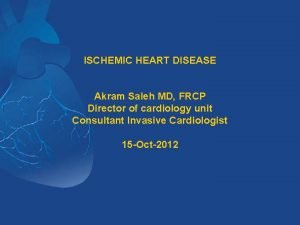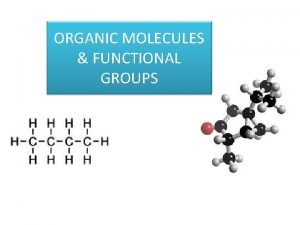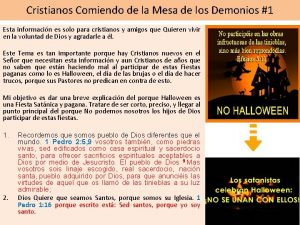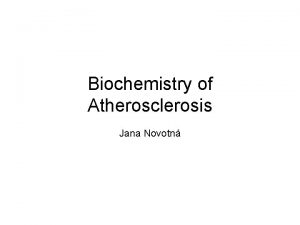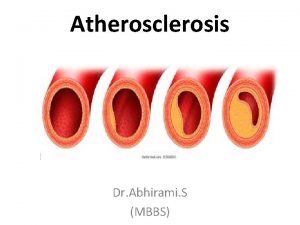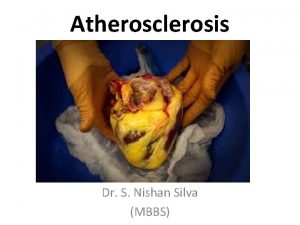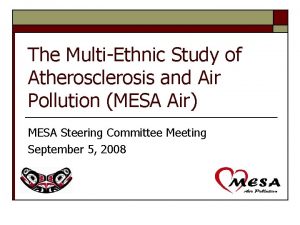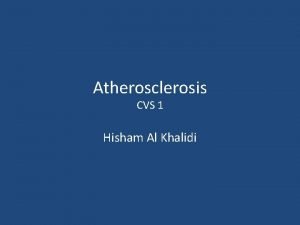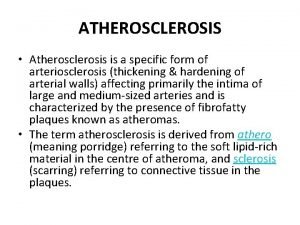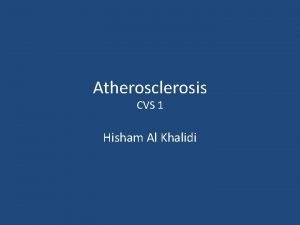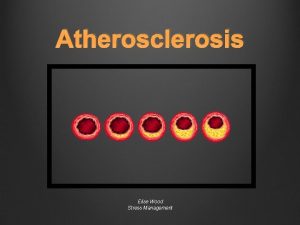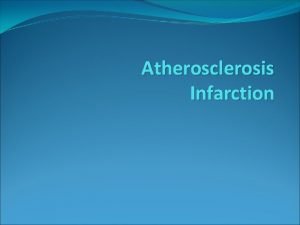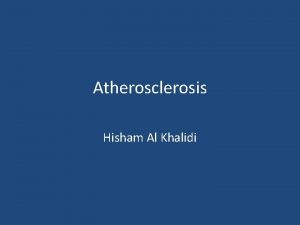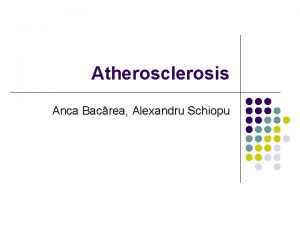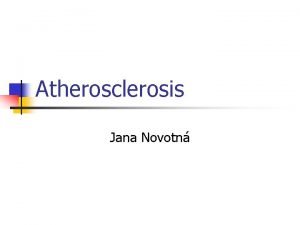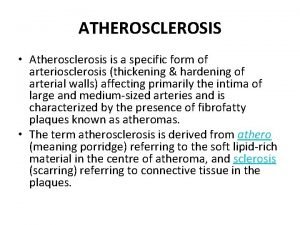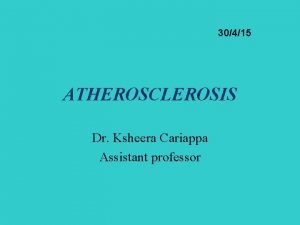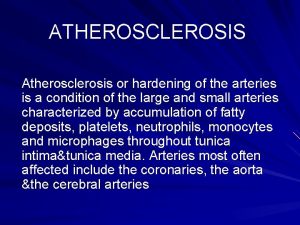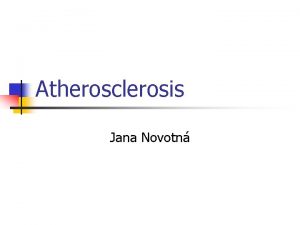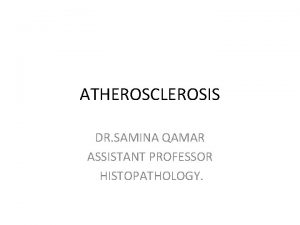MultiEthnic Study of Atherosclerosis MESA 1 MESA is





















- Slides: 21

Multi-Ethnic Study of Atherosclerosis (MESA) 1. MESA is a large (n=6, 814) multi-center NIH/NHLBI observational study of the pathogenesis and progression of subclinical atherosclerosis. • • Mean age 61. 4 years Study population- 38% White, 28% African American, 22% Hispanic, and 12% Chinese, with 53% women 2. Baseline blood samples permit study of relations of lipids and lipoproteins to carotid atherosclerosis (intima-media thickness, IMT), and shortly also to incident CVD events. 3. Lipoprotein particle measurements were performed by nuclear magnetic resonance (NMR) spectroscopy at Lipo. Science (Raleigh, NC) Publications to date: Mora S et al. , Atherosclerosis 2007; 192: 211 -217. Otvos et al. J of Clinical Lipidology 2011, epub. 1

Concordance/Discordance Between LDL-C and LDL-P in MESA Discordant LDL-P >LDL-C by +20 percentile Concordant < 20 percentile difference Discordant LDL-P < LDL-C by -20 percentile N (%) Cholesterol Molecules per LDL Particle 822 1837 (15%) Cholesterol-poor 3, 677 2392 863 3085 (69%) (16%) Cholesterol-rich LDL-C LDL-P (percentile) 105 1480 mg/d. L nmol/L (37 th) (73 rd) 119 1300 (55 th) 136 1145 (75 th) (36 th) Lipo. Science unpublished data 2

Cumulative Probability of Incident CVD Event LDL-P and LDL-C Discordance in MESA Relations with Incident CVD Events 0. 04 LDL-P>LDL-C 0. 03 0. 02 0. 01 LDL-P LDL-C 1448 107 1296 118 1175 133 Concordant LDL-P<LDL-C Follow-Up (Days) Otvos et al. J of Clinical Lipidology 2011

The Clinical Relevance of LDL-P vs LDL-C: The Issue of Discordance N (%) Overall 5, 362 Discordant 3, 071 ± 10 percentile Discordant ± 20 percentile Discordant ± 30 percentile IMT in µm per 1 SD LDL-P IMT in µm per 1 SD LDL-C 40. 8 35. 8 (p<0. 0001) 39. 4 23. 7 (57%) (p<0. 0001) (p=0. 0005) 1, 685 37. 0 4. 9 (31%) (p<0. 0002) (p=0. 62) 834 56. 1 1. 0 (16%) (p=<0. 0001) LDL-P 1592 nmol/l LDL-C 97 mg/dl (p=0. 94) LDL-P 1058 nmol/l LDL-C 147 mg/dl 4

COMETS Study Design Patients (n=401) RSV 10 mg (n=165) RSV 20 mg ATV 10 mg (n=157) ATV 20 mg Placebo (n=79) RSV 20 mg Metabolic syndrome CHD risk >10% Statin-naïve ≥ 18 years Visit: 1 Week: – 4 2 – 2 Dietary run in/ eligibility 3 0 4 6 5 12 Lipids hs. CRP Safety RSV=rosuvastatin; ATV=atorvastatin; hs. CRP=high-sensitivity C-reactive protein n=number of patients randomised Stalenhoef AFH et al. Eur Heart J 2005: 24: 2664 -72 5

COMETS: Percent LDL Lowering by Statin Monotherapy in Metabolic Syndrome Patients Rosuvastatin Percent Reduction 0 Atorvastatin 0 168 1960 10 10 20 20 30 1260 40 1210 38% 93 50 84 60 Baseline 6 weeks (10 mg) 50% 171 1870 Fewer LDL particles 1300 30 40 1260 105 95 50 33% 44% Less cholesterol per particle 60 12 weeks (20 mg) Less cholesterol per LDL particle LDL-C (mg/d. L) Baseline 6 weeks (10 mg) 12 weeks (20 mg) Less cholesterol per LDL particle LDL-P (nmol/L) 6 Rosenson RS and Otvos J, unpublished data

7 J of Clin Lipid. 2009, 3, 45 -50

8

LDL-P Reduction on S 20, S 80 and S 20/N at 12 months -10% -22% -35% -8% -21% -38% 9




Role of Lipoproteins in Type 2 Diabetes 13

Time Course of Type 2 Diabetes • Metabolic changes in T 2 DM occurs over time and hepatic insulin resistance manifests its earliest measurable abnormalities in changes in lipoprotein metabolism with modest change in fasting glucose levels. • The metabolic changes induced by or accompanying insulin resistance produce more extensive abnormalities in lipoprotein subclass levels and particle size distributions, elevation in triglycerides, and reductions in HDL cholesterol. • More specifically, NMR measured large VLDL and small LDL subclass particle concentrations are higher and large HDL subclass levels are lower in insulin resistant. NMR-measured VLDL, and HDL particle sizes also reflect insulin resistance status. 14

Results From the Insulin Resistance Atherosclerosis Study Normal Glucose Tolerance (NGT) Impaired Glucose Tolerance (IGT) Diabetes (DM) P values 433. 1 550. 8 636. 3 0. 0001 21. 4 21. 2 20. 9 0. 0001 2. 6 3. 5 4. 7 0. 0001 48. 1 51. 3 55. 2 0. 0001 Large HDL-P (umol/L) 5. 1 4. 5 3. 9 0. 0001 HDL-P size (nm) 9. 0 8. 9 8. 8 0. 0001 Small LDL-P (nmol/L) LDL-P size (nm) Large VLDL-P (nmol/L) VLDL-P size (nm) NMR Lipoprotein Particle Concentrations In Normal Glucose Tolerance (NGT), Impaired Glucose Tolerance (IGT), Diabetes (DM) Subjects 15 Goff, Metabolism 2005; 54: 264 -70

Women’s Health Study Adjusted hazard ratios for the association of lipoprotein measure with incident type 2 diabetes in quintiles 1 through 5 Small LDL-P (nmol/L) LDL-P size (nm) Large VLDL-P (nmol/L) VLDL-P size (nm) Large HDL-P (µmol/L) HDL-P (nm) Quintile 1 (<346) Quintile 2 (347 -553) Quintile 3 (554 -774) Quintile 4 (775 -1134) Quintile 5 (>1134) Ref. 1. 54 2. 09 2. 62 4. 04 Quintile 1 (<20. 5) Quintile 2 (20. 6 -21. 0) Quintile 3 (21. 1 -21. 5) Quintile 4 (21. 6 -21. 9) Quintile 5 (>21. 9) 4. 16 3. 04 2. 21 1. 63 Ref. Quintile 1 (<0. 1) Quintile 2 (0. 2 -0. 5) Quintile 3 (0. 6 -1. 8) Quintile 4 (1. 9 -3. 8) Quintile 5 (>3. 8) Ref. 1. 49 2. 54 2. 98 3. 11 Quintile 1 (<40. 6) Quintile 2 (40. 7 -43. 8) Quintile 3 (43. 9 -47. 3) Quintile 4 (47. 4 -52. 0) Quintile 5 (>52. 0) Ref. 1. 25 1. 67 2. 22 2. 80 Quintile 1 (<4. 0) Quintile 2 (4. 1 -5. 8) Quintile 3 (5. 9 -7. 7) Quintile 4 (7. 8 -10. 0) Quintile 5 (>10. 0) 4. 51 3. 19 2. 54 1. 72 Ref. Quintile 1 (<8. 5) Quintile 2 (8. 6 -8. 7) Quintile 3 (8. 8 -9. 0) Quintile 4 (9. 1 -9. 4) Quintile 5 (>9. 4) 4. 56 3. 97 3. 08 1. 72 Ref. Mora et al. 2010. Diabetes 16

Time Course of the Pathogenesis of Type 2 Diabetes 17


Decreasing Density / Density (g/ml) What are various types of Lipoproteins? 0. 95 VLDL IDL 1. 006 1. 02 Apo A 1 1. 06 1. 10 LDL Cholesterol HDL 2 HDL 3 1. 20 5 Chylomicron Remnants HDL Cholesterol 10 20 Triglycerides (mainly) Apo B 40 60 Increasing Size /Diameter (nm) 80 1000

Lipoprotein Particle Structure (VLDL, IDL) Apolipoprotein B (Apo B) POLAR SURFACE COAT NONPOLAR LIPID CORE Phospholipid Free cholesterol Cholesterol Ester Triglyceride

Lipoprotein Particle Structure (HDL) Apolipoprotein A 1 (Apo A 1) POLAR SURFACE COAT NONPOLAR LIPID CORE Phospholipid Free cholesterol Cholesterol Ester Triglyceride Apolipoprotein A 1 (Apo A 1)
 Whats ethnicity mean
Whats ethnicity mean States i have been to
States i have been to Nation state
Nation state Multiethnic state definition
Multiethnic state definition Atherosclerosis
Atherosclerosis Ischemic heart disease
Ischemic heart disease Atherosclerosis
Atherosclerosis Mild atherosclerosis
Mild atherosclerosis Atherosclerosis
Atherosclerosis Aortic arch branches
Aortic arch branches Atherosclerosis
Atherosclerosis Atherosclerosis tunica intima
Atherosclerosis tunica intima Atherosclerosis plaque development
Atherosclerosis plaque development Dna structure
Dna structure Que significa comer de la mesa de los demonios
Que significa comer de la mesa de los demonios What is case series
What is case series Phytogeography region of india
Phytogeography region of india Retrospective cohort study
Retrospective cohort study Distinguish between motion study and time study
Distinguish between motion study and time study Process of method study
Process of method study Distinguish between time study and motion study
Distinguish between time study and motion study Marty lobdell study less study smart
Marty lobdell study less study smart




